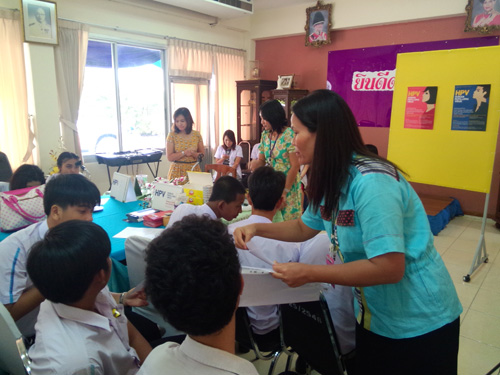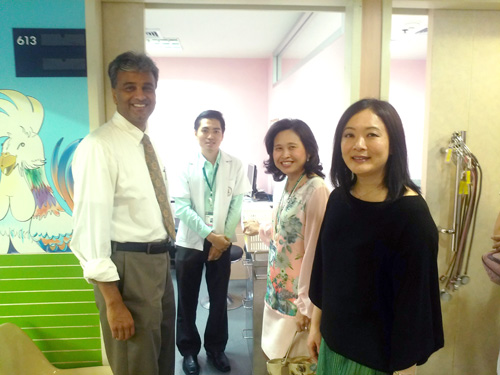Study Shows HIV-Positive Adolescents in Asia Are at Increased Risk of High-Risk HPV
Published July 14, 2015

Ms. Yuitiang Durier, pediatric social worker at Siriraj Hospital, conducts outreach activities for the study at a school in Bangkok.
People living with HIV who are co-infected with the human papillomavirus (HPV) are far more likely to develop the cervical and anal cancers associated with HPV than their HIV-negative counterparts. However, despite the fact that most sexually active adults have been exposed to HPV, there has been limited previous research about HPV co-infection among perinatally HIV-infected young people or its impact on their rates of cancer.
In 2013, TREAT Asia, working in partnership with the Thai Red Cross AIDS Research Centre, launched a five-year study funded by the Eunice Kennedy Shriver National Institute of Child Health and Human Development at the U.S. National Institutes of Health to evaluate HPV risk and prevalence among both HIV-positive and -negative females and males up to age 24 at five clinical sites in Thailand and Vietnam. Preliminary analysis shows that while the HIV-positive female study participants had lower rates of risky sexual behavior than the HIV-negative participants, they had higher rates of infection with high-risk strains of HPV that are associated with cancer and of abnormalities of the cervix (called neoplasia) that can be precursors to cancer.
“An increasing proportion of perinatally HIV-infected children in our region are entering their adolescent years, and knowing which HPV genotypes are common among them will help support and speed up the implementation of HPV vaccination programs in the region,” says the Thai Red Cross’s Dr. Nittaya Phanuphak, who is co-leading the study with TREAT Asia Director Dr. Annette Sohn. “Also, the data around prevalence and incidence of cervical pre-cancerous lesions can be used to guide how cervical cancer screening should be implemented for this population.”

(From left to right): Dr. Rohan Hazra, U.S. National Institutes of Health; Thanaporn Nimsomboon, Siriraj Hospital; Dr. Kulkanya Chokephaibulkit, Siriraj Hospital; and Dr. Annette Sohn, TREAT Asia/amfAR, during an HPV study site visit at Siriraj Hospital in Bangkok
The study team has conducted HPV screenings in 300 young people. The team found that 42% of the HIV-positive female participants had high-risk strains of anal HPV, compared to 23% among the HIV-negative group, and that 40% had high-risk cervical HPV, compared to 30%. In addition, 16% of the perinatally infected females had low-grade cervical lesions caused by HPV, compared to 1.5% of the HIV-negative group. These results caused the team to urge that perinatally infected girls be prioritized for HPV vaccination in the region, especially in countries where vaccine availability is limited.
The HPV vaccine, which prevents infection with the two HPV genotypes that cause 70% of cervical cancers, is most effective if given during early adolescence when HPV exposure is less likely to have occurred through sexual contact. It first became available in 2006, but due to its high cost (as much as US$140 per dose in high-income countries), few lower-income countries have launched national vaccination programs. However, in 2013 the price in lower-income countries dropped substantially (to as low as US$4.50 per dose), and many countries, including Vietnam, have launched limited pilot rollouts through funding from GAVI, The Vaccine Alliance, in preparation for launching national programs. Thailand has launched its own nationally funded pilot program and plans to launch a countrywide program over the next five years.
But even national plans to offer the vaccine free of charge are no guarantee that all perinatally infected children will be offered and accept vaccination, and the study team is hoping to use their data to help develop strategies for offering it in conjunction with HIV care to ensure that all HIV-positive adolescents are vaccinated. Over the remaining years of the study, researchers will continue to monitor for HPV risk factors and the progression of high-risk HPV infections and pre-cancerous lesions to better understand the impact of long-term co-infection in young people.
“Our research can directly inform how countries in the Asia-Pacific begin allocating resources for HPV vaccine programs,” says Dr. Sohn. “Even these initial results are showing us that young people living with HIV need this vaccine now to prevent cancer in the future.”